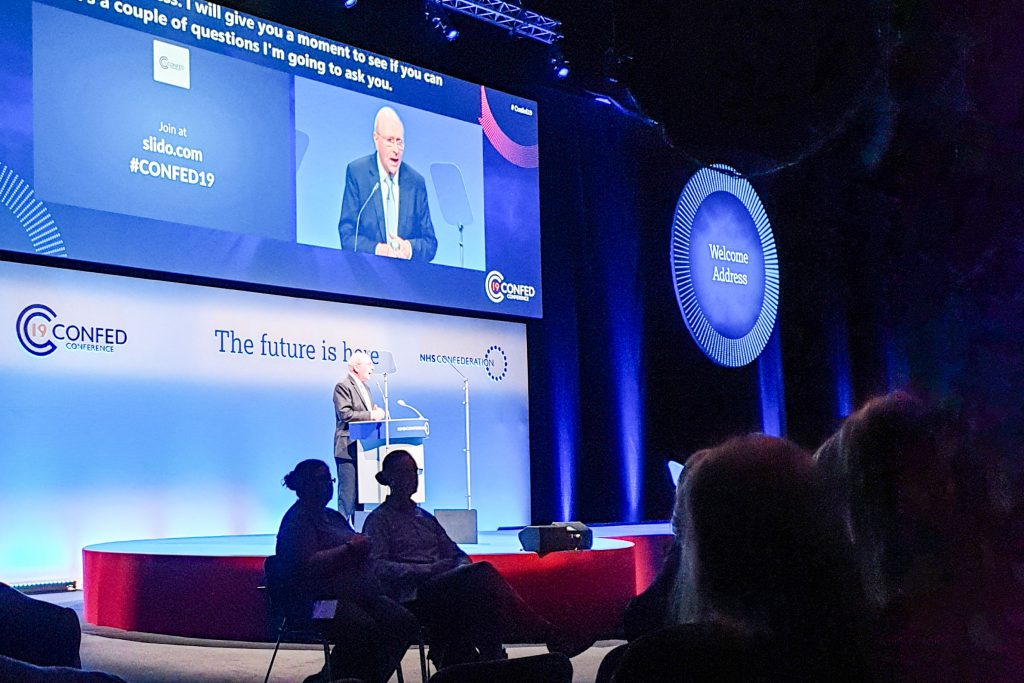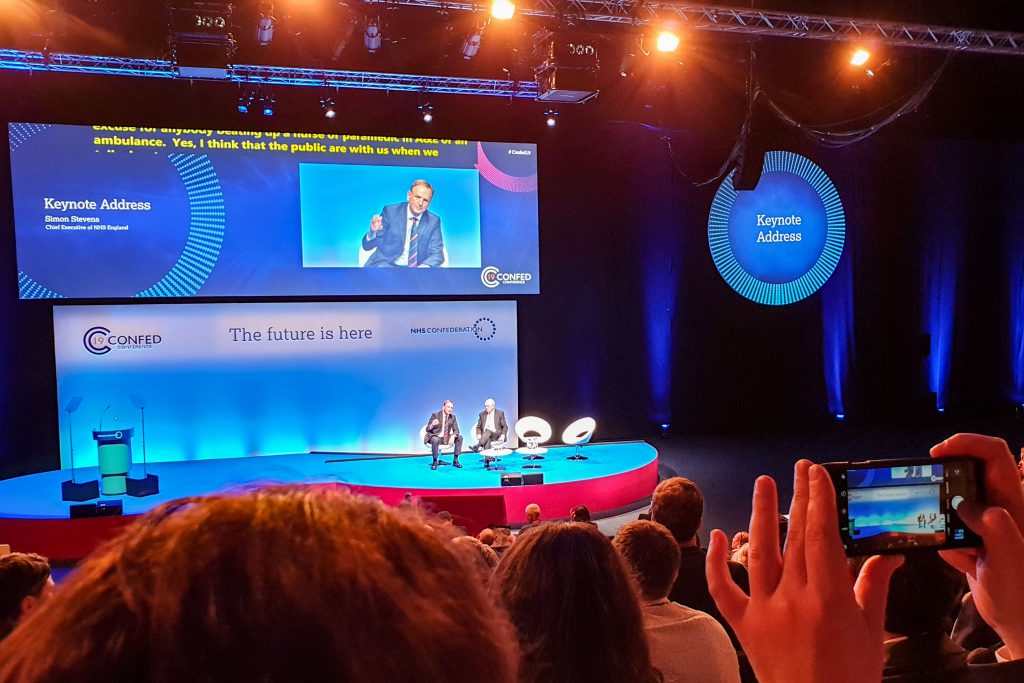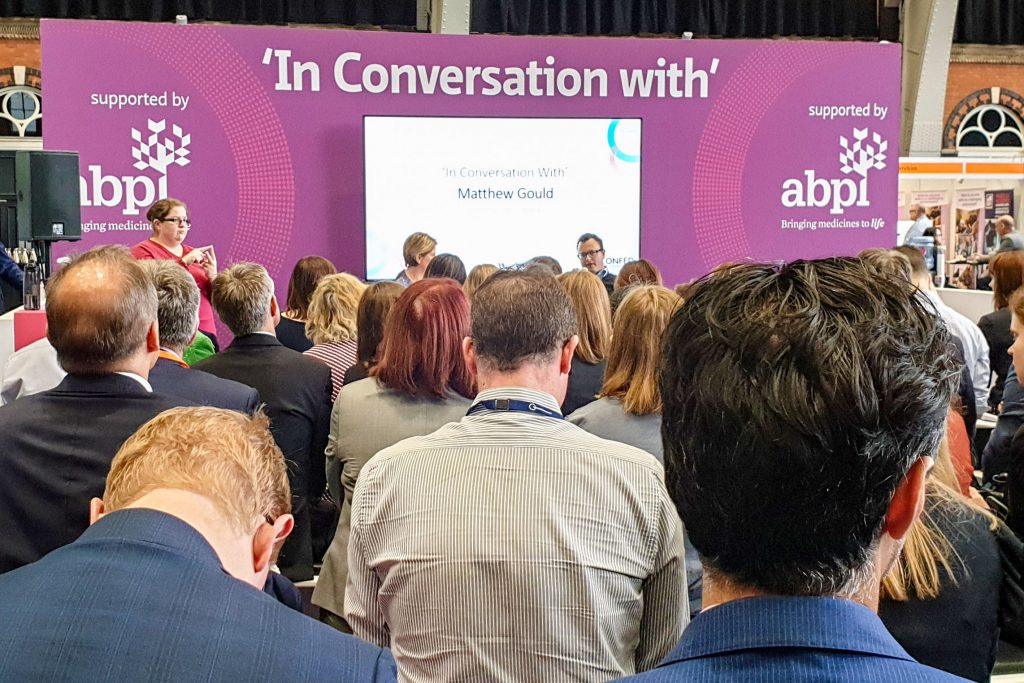The NHS Confederation’s annual conference took place in Manchester from 19 to 20 June, but there was a sense that its normally attention-grabbing agenda had been curtailed by the Conservative Party leadership campaign taking place in London. Lyn Whitfield reports.
As Confed 19 took place in Manchester, there was a distinct sense that the action was in London. Health and social care secretary Matt Hancock, who the previous week had launched a Conservative Party leadership campaign, abandoned it, and endorsed Boris Johnson, did not attend.
Nor did his ministerial team, senior civil servants, or the political and news correspondents who follow them. So, when the NHS Confederation published a report with the Health Foundation that warned last year’s 70th anniversary “birthday present” was not “job done” on funding, it received less attention than it would have done normally.
Job done on health and care funding?

The report points out that although the £20.5 billion announced by prime minister Theresa May sounds generous, the figure will only be reached by 2023-24; and much of the money is “backloaded” to the end of this period.
“A big chunk” will go on pay, and more will be set aside for the NHS Long Term Plan’s commitments on primary care, mental health, cancer and children’s services.
Once those items are accounted for, lead author Anita Charlesworth calculated that the uplift for existing services will be 2.3% a year over the next five years; less than the 2.7% think-tanks were calling for ahead of NHS70, and a long-way below the 3.7% increase in hospital activity last year.
Added to which, the money only covers the NHS in England; and not capital investment, training, public health or social care. To address these issues, Charlesworth argued, spending would have to rise by another £8 billion, to 4.1% a year.
Which, she added, would almost certainly mean some kind of tax-rise, as the NHS already takes up so much of the government’s budget that cuts elsewhere could leave it as a “rescue service”; picking up the pieces left by the underfunding of what remains of the rest of the public sector.
More money, and tax rises to pay for it sound unlikely when the Conservative Party leadership contest has been dominated by Brexit and wild promises of tax cuts. But NHS Confederation chief executive Niall Dickson soldiered on; using his keynote speech to argue that more money will be needed to deliver new ways of commissioning, integrating and delivering services.
“There is a lot of transformation going on, but the big question is whether it can continue over the next five to ten years,” he said. “Without the NHS Long Term Plan it would be well-nigh impossible… but if it is to be successful the government must complete the unfinished business of funding health and care.”
Brexit in the channel, Kent cut off
In the meantime, the NHS has plenty to be getting on with. Starting, in the short-term, with Brexit. In a break-out session, Professor Keith Willett, the NHS director of acute care, said no-deal planning will ramp up again from 1 July.
As he pointed out, while there can be “no clarity on the politics”, none of the remaining Conservative Party candidates “has a deal on the table”, so with UK and EU law saying the UK will depart on 31 October, the risk of crashing out is “certainly not zero.”
Professor Willett sounded reasonably confident that new, non-Dover supply routes for medicines, and buffer stocks of up to 14 weeks, would avoid shortages of critical medicines.
But Susan Acott, the chief executive of East Kent Hospitals NHS Foundation Trust, said potential gridlock around ports could have “profound” implications for coastal communities, ambulance services, and staff; with social care workers unable to reach care homes and vulnerable individuals a particular concern.
Cheeringly, Matthew Swindells, the outgoing deputy chief executive of NHS England, who was in the audience, pointed out that this time around the NHS will need to prepare for Brexit just as it gets ready for winter and “plans for keeping systems and beds open will need to factor this in.”
No turning back on reform

In the medium term, there is that transformation challenge. Simon Stevens, the chief executive of NHS England and leader of NHS Improvement, did turn up to Confed 19 and he pointed out that, whatever the shortcomings of last year’s financial settlement, it was multi-year and considerably more than other services have got.
Given that, he said that “if we are being self-critical” not enough has happened in the past year. Stevens is a recent convert to the joys of ocean sailing, and he suggested the health service has “acquired barnacles” over time. It needs to “scrape some off” to get itself moving faster.
To help with the scraping, NHS England/Improvement will be publishing a framework for implementing the NHS Long Term Plan in the last week of June. Healthcare communities will be expected to use this to develop their own plans this autumn.
To underline his repeated insistence that population-level planning and integrated care systems are “the only game in town”, Stevens also announced three new integrated care systems for the south of England; taking the number of people covered by accountable care arrangements to 21 million.
Finding the people
A good third of Stevens’ speech, though, was devoted to one of the long-term challenges facing the NHS, which is staffing. Brexit is hardly helping, here.
Susan Acott told the break-out session that around 5% of NHS staff come from the EU, rising to 13% in some parts of the south east, and many of them could leave if they no longer feel welcome or the pound crashes, taking the Euro value of their wages with it.
But the real issue is ageing; as the proportion of young people in the population falls and the proportion of older people rises, the NHS will be competing for a shrinking pool of workers to meet expanding demand.
Stevens called for better leadership, more diversity, and for HR to “get its mojo back” to tackle the issue; and for the NHS to go out and sell itself to young people as a great place to build a career.
In fact, he suggested, at a time of “strain and division” in the country, the NHS should think about how it could position itself as an “anchor institution”; and take the lead on issues from climate change to knife crime and vaccination.
Social care: a crisis that is not going away
This might have sounded abstract or fanciful, but “in conversation with” Victoria Macdonald out in the exhibition hall, Health Service Journal editor Alastair McLellan reminded the conference what happens to public services that are not politically influential or part of the national debate.
Talking about the plight of social care, he said: “I cannot think of anything that worries me more except, perhaps, for climate change.” But, he said, “politicians are so terrified” of getting the public to face up to the costs of funding proper provision that it could take “something terrible” to make them act.
“We know that the answer is some combination of wealth tax and insurance in people’s lifetimes, but suggesting that is a political death sentence,” he said; pointing out that Theresa May’s “death tax” proposals had contributed to the general election disaster that led to the present Brexit and leadership crisis.
Tech goes missing from action
There was plenty of optimism in Manchester. Some of the integrated care systems that are up and running made it out of the side rooms and onto the main stage to talk about their work this year.
Amanda Doyle, the leader of Healthier Lancashire and South Cumbria, said that five years ago, “it felt like we were trying to do a jigsaw without the picture on the box” but now the area felt it had the big picture and that some of the pieces were falling into place.
She said the area was planning to use population health management approaches to risk stratify the population “to see how we can plan interventions and target them to individuals.” What she didn’t say was where the data to drive this transformation agenda was going to come from.
But then, technology was missing from the Confed 19 jigsaw. NHS Digital put on a lively “digital breakfast”, at which chief executive Sarah Wilkinson talked about the potential of biometrics, voice and sensors in detecting and treating disease, and her colleagues Jackie Gray and Rob Shaw talked about the imperative to maintain privacy and cyber security as this near-future tech comes on stream.
But across the conference, there was no discussion of the NHS IT strategy embedded in the NHS Long Term Plan. Or input from the big global digital exemplar and local health and care record exemplar programmes, which are under review ahead of the departure of Matthew Swindells.
Or focus on the Empower the Patient programme, which is being scaled back following the departure of Juliet Bauer earlier this year.
Will NHSX survive, and will the Treasury listen to it?

Matthew Gould, who is about to start work as chief executive of NHSX, did appear at another “in conversation with” session. Victoria Macdonald asked him straight out whether the new unit would survive the likely departure of Matt Hancock “for his expected place at the Treasury” at the end of the Conservative Party leadership campaign.
Gould stuttered badly over this one, but eventually said he thought it would have a future, because senior NHS leaders “see the sense in creating a single entity, apart from NHSE/I, that can pull levers and drive the digitisation of the NHS.”
“Whether Matt goes or not, this needs to be done, and NHSX is a step forward,” he said; although he insisted that he was not planning “a Pol Pot-style regime” in which tech was “reset to ground zero.”
Macdonald did not press him on why, in that case, so many projects are being stopped or rethought; but she did extract from Gould that his travels around the NHS have left him with the sense that its big IT problems are “basics” like poor connectivity, slow login times, and interoperability.
This, plus recent indications that the DHSC is interested in helping digital ‘laggards’, perhaps through targeted spending, perhaps through joint procurements with stronger trusts, suggests a shift in focus. Attention seems to be shifting away from “world class” IT and towards the basic level of digitisation mentioned in the NHS Long Term Plan.
Gould acknowledged that even sorting out the basics will cost money and indicated that conversations are underway about this ahead of the comprehensive spending review that is expected to survive the change of administration.
But also said Treasury colleagues have expressed “scepticism” about whether putting more money into IT will deliver productivity improvements or benefits for staff. Gould told his audience he believes the scepticism is “misplaced”; but there is “a job to do” to marshal the evidence and persuade the Treasury that “this time” IT is going to work.
Limelight required

It was fairly obvious last summer that former health and social care secretary Jeremy Hunt played a blinder when he teamed up with Stevens to use NHS70 to pressure Downing Street into getting £20.5 billion out of chancellor Philip Hammond.
It might not be everything the NHS would like, and it won’t solve the workforce problem or the social care crisis. But the absence of political interest, funding announcements, and policy initiatives at Confed 19 showed the extent to which the NHS benefited from having a Cabinet big-hitter in charge of it for a long time.
Now, NHS leaders and lobbyists want the Treasury to finish the job by sorting out capital funding, public health budgets, and social care.
To be in with a chance, they will have to hope that once Hunt has become Conservative Party leader and prime minister (or not) and Hancock has moved on to the Treasury (or wherever) and Brexit has been resolved (or otherwise), the NHS gets another powerful champion willing to grapple with its issues. NHS IT may need to do the same.



